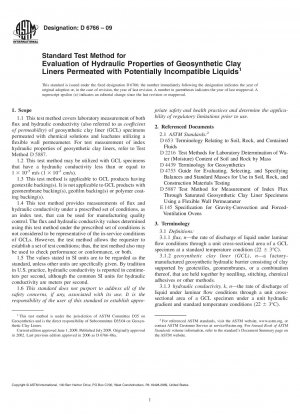ASTM D6766-09
Standard Test Method for Evaluation of Hydraulic Properties of Geosynthetic Clay Liners Permeated with Potentially Incompatible Liquids
- Standard No.
- ASTM D6766-09
- Release Date
- 2009
- Published By
- American Society for Testing and Materials (ASTM)
- Status
- Replace By
- ASTM D6766-12
- Latest
- ASTM D6766-20a
- Scope
This test method applies to one-dimensional, laminar flow of water or other permeation liquids, such as chemical solutions, landfill leachate, and contaminated water (here on referred to as test liquid), through saturated/hydrated GCL specimen that is consolidated and permeated under a prescribed or requested set of conditions.
This test method can be performed to determine if the flux and/or hydraulic conductivity of a GCL specimen exceeds the maximum value stated by the manufacturer or required by the regulatory agencies, or both.
It is assumed that Darcy''s law is valid and that the hydraulic conductivity is essentially unaffected by hydraulic gradient. The validity of Darcy''s law may be evaluated by measuring the hydraulic conductivity of the specimen at three different hydraulic gradients; if all measured values are similar (within about 25 %), then Darcy''s law may be taken as valid. However, when the hydraulic gradient acting on a test specimen is changed, the state of stress will also change, and, if the specimen is compressible, the volume of the specimen will change. Thus, some change in hydraulic conductivity may occur when the hydraulic gradient is altered, even in cases where Darcy''s law is valid.
This test method provides tools for determining flux and hydraulic conductivity values for a given GCL under the following two different scenarios, which should be specified by the requester:
Scenario 1—Hydrated/Saturated with Water Prior to Contact with Test Liquid 8212;This scenario simulates the field conditions where the GCL is well hydrated with water prior to contact with actual test liquid. It should be noted that initial degree of saturation/hydration greatly affects the hydraulic properties of a GCL product. The test has two phases: (Phase 1) hydrate, saturate, consolidate and permeate with water as Test Liquid 1, and (Phase 2) switch to permeation with test liquid as Test Liquid 2.
Scenario 2—Hydrated/Saturated with Test Liquid (Worst Case)8212;This scenario simulates the field conditions where the GCL is in contact with test liquid prior to being fully hydrated with water. It should be noted that this scenario may result in higher flux and hydraulic conductivity values compared to Scenario 1 as chemicals present in test liquid may alter the hydration and hydraulic properties of a GCL product.
The apparatus used in this test method is commonly used to determine the hydraulic conductivity of soil specimens. However, flux values measured in this test are typically much lower than those commonly measured for most natural soils. It is essential that the leakage rate of the apparatus in this test be less than 10 % of the flux.
1.1 This test method covers laboratory measurement of both flux and hydraulic conductivity (also referred to as coefficient of permeability) of geosynthetic clay liner (GCL) specimens permeated with chemical solutions and leachates utilizing a flexible wall permeameter. For test measurement of index hydraulic properties of geosynthetic clay liners, refer to Test Method D 5887.
1.2 This test method may be utilized with GCL specimens that have a hydraulic conductivity less than or equal to 1 × 10-5 m/s (1 × 10-3 cm/s).
1.3 This test method is applicable to GCL products having geotextile backing(s). It is not applicable to GCL products with geomembrane backing(s), geofilm backing(s) or polymer coating backing(s).
1.4 This test method provides measurements of flux and hydraulic conductivity under a prescribed set of condit......
ASTM D6766-09 Referenced Document
- ASTM D2216 Standard Test Method for Laboratory Determination of Water (Moisture) Content of Soil and Rock by Mass
- ASTM D4439 Standard Terminology for Geosynthetics
- ASTM D4753 Standard Specification for Evaluating, Selecting, and Specifying Balances and Scales for Use in Soil, Rock, and Construction Materials Testing
- ASTM D5887 Standard Test Method for Measurement of Index Flux Through Saturated Geosynthetic Clay Liner Specimens Using a Flexible Wall Permeameter
- ASTM D653 Standard Terminology Relating to Soil, Rock, and Contained Fluids
- ASTM E145 Standard Specification for Gravity-Convection And Forced-Ventilation Ovens
ASTM D6766-09 history
- 2020 ASTM D6766-20a Standard Test Method for Evaluation of Hydraulic Properties of Geosynthetic Clay Liners Permeated with Potentially Incompatible Aqueous Solutions
- 2020 ASTM D6766-20 Standard Test Method for Evaluation of Hydraulic Properties of Geosynthetic Clay Liners Permeated with Potentially Incompatible Aqueous Solutions
- 2018 ASTM D6766-18 Standard Test Method for Evaluation of Hydraulic Properties of Geosynthetic Clay Liners Permeated with Potentially Incompatible Aqueous Solutions
- 2012 ASTM D6766-12 Standard Test Method for Evaluation of Hydraulic Properties of Geosynthetic Clay Liners Permeated with Potentially Incompatible Aqueous Solutions
- 2009 ASTM D6766-09 Standard Test Method for Evaluation of Hydraulic Properties of Geosynthetic Clay Liners Permeated with Potentially Incompatible Liquids
- 2006 ASTM D6766-06a Standard Test Method for Evaluation of Hydraulic Properties of Geosynthetic Clay Liners Permeated with Potentially Incompatible Liquids
- 2006 ASTM D6766-06 Standard Test Method for Evaluation of Hydraulic Properties of Geosynthetic Clay Liners Permeated with Potentially Incompatible Liquids
- 2002 ASTM D6766-02 Standard Test Method for Evaluation of Hydraulic Properties of Geosynthetic Clay Liners Permeated with Potentially Incompatible Liquids
